
- Home
- Memories
- Scrapbook ▽
- Topics ▽
- People ▽
- Events
- Photos
- Site Map
- Timeline
Updated 9th July 2013
The pretty little town of Topsham was once the second busiest port in England. Now it is a favourite destination for the retired, and tourist alike.
It is thought that the name derives from Topp who was an Anglo Saxon landowner, while ham is a small village or settlement. There have been many variations of the name including Apsham, Apsam, Toppeshore, Toppeshant and Toppesham.
The town is sited on a low red ridge between the main river of the Exe to the west and the River Clyst, to the south. The Exe at this point is an estuary of some width with salt marshes on its opposite bank.
There is evidence of Mesolithic (6,000 to 10,000 years ago) hunting in Topsham and Neolithic tools, including a stone axe, have also been found. Archaeologists, in 1999, uncovered two ditches in Butts Park that indicate the Romans built a fort in the 1st Century. The straight line of the Topsham Road running up to Exeter, is due to their road building skills.
Although the Exe was navigable as far as the quayside in Exeter, Topsham has had port facilities from Roman times. It was the Countess Isabella de Fortibus who built a partial weir across the river in the 1290's to run her mills, and that in a stroke, cut off Exeter's port from the sea and allowed Topsham's port to expand and control the trade with Exeter. In 1300, Hugh de Courtenay was granted the Manor of Topsham by Edward I, allowing him to hold a market on Saturdays and also hold an annual three day Festival of St Margaret - and a village with a market became a town!
Courtenay also ensured the river remained unnavigable when "he caused the channel which had been for the passage of ships and boats, to be again filled entirely up, and this was done at a great expence, by cutting down a great number of trees, which, being chained together, were laid in the channel, with great quantities of stones and gravel; these, in time, so united together as to make their removal impracticable." (Jenkins);
Things obviously weren't good between the Courtenay's and the city - "Adding to his revenge, he also erected a Quay and a Crane at his mansion of Topsham, hoping thereby to remove the whole commerce of the Citizens, and to benefit, himself and tenants." The monopoly enabled Topsham to develop a larger trade with the Continent than any other port in England, other than London, all due to Courtenay's action.
The city to the north made many petitions to the monarch for the weir to be removed, but it wasn't until Henry VIII brought about the demise of the Courtenay's that changes were made that would alter Topsham's flourishing port. Henry Courtenay, was detained and executed in 1538 for conspiracy, and all his lands were confiscated. Two years later Exeter was finally granted permission to open up Countess Wear for navigation - however, the river had heavily silted up and it was found to be impractical.
Between 1563 to 1566, John Trew was engaged to cut a canal between Exeter and the estuary that would allow ships to navigate up to Exeter's own quay. The canal was only 3ft deep, and over time silted up, but it showed the way for the persistent city. Meanwhile the port of Topsham was busy, equipping ships for the arduous journey to the New World, and importing salt cod from the Newfoundland banks. Queen Elizabeth granted a Charter allowing the merchants of Exeter to import French wines and fruit, most of which was landed at Topsham. Shipbuilding was becoming important to the town, and part built trading and fishing vessels were lining the banks of the Exe, surrounded by a busy workforce.
In 1588, Topsham, along with Exeter, supplied and equipped three ships, The Rose, The Bartholomew and The Gyfte which was built at Lympstone, to fight the Armada. They left port on 16th July to join the English fleet, and returned on the 9th September, costing the town £447 16 shillings. The first coal to be imported into Topsham occurred in 1599 - over the years imports increased from the coal fields in South Wales and the North East to fuel the local paper mills, lime kilns and foundries.
Topsham became an important stronghold for Royalist forces during the Civil War when the Cornish force of Sir Ralph Hopton occupied the town in November 1642. The town became part of the Royalist siege of Exeter, which the Parliamentary fleet commanded by the Earl of Warwick tried to relieve, by landing at Topsham. The action was a disaster and the defenders sank two lighters attempting to land, captured two of Warwick's ships, and burnt a third, forcing the Parliamentary fleet back to sea.
In 1645, General Fairfax drove the, by now, weakened Royalist forces out of Topsham, and occupied the town as part of his siege of Exeter, prior to the surrender of the city in April 1646.
One of the biggest problems for Exeter and Topsham merchants, in the 17th Century, was the number of Turkish, Algerian and Tunis pirates that prayed upon its ships. In 1636 the Swan of Topsham was set upon by two Turkish men o'war near the Scillies, forcing the Swan to run ashore to save itself. Similarly the Lark of 80 tons and fifteen men and boy was taken, the Patience two days out to Newfoundland, and the barque the Rose Garden, all lost to pirates. Admiral Robert Blake was sent to drive off the pirates in 1654, with some success, but the pirates continued to harass local shipping. Having a share in a ship could lead to riches or to ruin.
Oliver wrote in 1861, "About 1675 the Chamber commenced the extension of the canal to the Topsham Sluice, called in later documents after its keeper, Trenchard's Sluice." A William Bayly was employed for the works, but all he managed to do was make the canal worse, before absconding with the funds. It would be twenty five years before the improvements were completed.
In the 17th Century, the booming export trade of serge from the Exeter mills made Topsham one of the busiest ports in England. The ports importance can be judged by the fact that it was used to land the baggage, ammunition and stores of William of Orange, when he landed in England in 1688, to take the throne with his wife, Mary.
In 1681, over a million pounds worth of serge passed through the port and along the Topsham Road and Holloway Street to Exeter on carts. At the end of the 17th Century, it was said that Topsham had more vessels berthed than any other port in the Kingdom, apart from London. Exeter had controlled the port from 1607 when the lease for the wharf, cranage and cellars was granted to the Mayor of the City. In 1769, the City acquired the quay and then, three years later, embarked on improving the canal, which would culminate in a new entrance at Turf Lock, opened in 1827 and the canal basin in 1830.
Many of the houses in Topsham have Dutch style frontages, dating from 1700 to 1730. Dutch tiles and bricks were brought in as ballast in ships that were exporting wool to Holland. Ancillary industry provided employment, products for Exeter and imports of raw materials through Topsham's quay. Jenkins wrote in 1805, "And a sugar-house and glass-house were built between this city and Topsham, which employed a great many labourers, to the general benefit of the country." These two industries were at Countess Wear.
In the nineteenth century trade through the port was healthy, with few predicting the decline that would follow the coming of the railway to Exeter, in 1844. A great storm in 1823 moved the channel between Exmouth and Dawlish Warren just at a time when ships were becoming larger. Additional silting of the channel into the port and the completion of the last great extension of the canal to Turf, saw an increasing number of ships unloading their cargoes into lighters, for transportation up the recently enlarged canal or to Topsham quay. The quays at Topsham were serving smaller ships, especially fishing vessels.
Ship building went through a revival from around 1790 when there were at least seven shipbuilders in the town, up until 1815. From the turn of the century until 1830 at least 92 vessels were built in the Topsham yards. Topsham yards built 27 warships, with one, the frigate Fawn, the largest at 500 tons. The largest ship to be built was the General Chasse, a barque of 540 tons and one of the last, the Silurian of 499 tons, was launched in 1870. John Holman, a master mariner was one of Topsham's major ship builders who founded the West of England Marine Insurance Company, that grew to became one of the countries largest marine insurance companies. His yard employed in the 1850s upwards of 200 men and 80 apprentices. The introduction of iron ships saw a rapid decline in shipbuilding in the town, with the only iron ship from Topsham launched from the Holman yard. The yard closed in 1874 and was converted into a dry-dock for ship repairs.
Shipbuilding supported many other activities - sail making, rope making, chain and anchor forging, sack making and nail making. John Holman also set up a nail works on the Strand which was later taken over by the Wigzell Brothers.
An advert for the passenger steamship, Ormrod, to Topsham from London, via Ryde or Cowes, appeared in the Times in January 1832, just 17 years after the first steamship to cross the Channel; this was eight years before the first steamship reached Exeter. A few years later, the steam packet Zephyr would regularly leave Topsham for Cowes, Portsmouth and London every Saturday for the three day trip, and return on the Wednesday. It was having to compete with the newly opened Great Western Railway, but none the less, provided a useful service for a few years, at a cost of 10 shillings on deck and one guinea in a cabin.
Meanwhile, the town of Topsham was adding new amenities such as paving, drains and an organised cleansing service. Gas lighting was introduced in 1849 by the Topsham Gas & Coke Co. For a short time the Topsham Herald was printed, but the town was too small to really support its own newspaper.
On 1 May 1861, the railway passed Topsham on the way to Exmouth and a 650 metre branch line was built to the quay, opening on the 23 September of the same year. It emerged by the Lighter Inn, to connect with the steamer quay. The branch line could only take one engine and eight loaded wagons, reduced to four in wet weather, due to the up to 1 in 38 incline. The engine was never allowed past the road that crossed the line by the quay and double gates were kept padlocked when not in use. Guano was unloaded in baskets at the quay and loaded into the waiting wagons. The railway also brought in barrels from Peterhead which were used to pack sprats that had been landed by Topsham boats; they were a return cargo for the Tuborg lager boats. Sprats in half pound bundles were also transported by train from the quay.
At the height of the railway's popularity, forty trains a day would pass through Topsham station taking holiday makers to and from Exmouth. The branch line closed in 1957 and was removed in August 1958, creating Holman Way and leaving an important local passenger service between Exeter and Exmouth. The goods yard at the station was closed in 1967; its sidings had been used for incoming timber and domestic coal for the town and outgoing soft fruit. One local nursery that specialised in growing orchids would sometimes despatch up to 30 consignments per day from the yard.
By the end of the nineteenth century the town had lost much of its trade through its port, and shipbuilding had gone. Fishing from the port declined, although in the last decade of the nineteenth century, there were still about 100 men employed fishing for salmon.
Vivian Leigh, the actress who played Scarlet O'Hara in Gone With the Wind often visited Topsham when she married her first husband, Leigh Holman at the age of 18, in 1932. Holman, a barrister and member of the ship insurance family was thirty years her senior. Leigh met Lawrence Olivier in 1937 and soon after embarked upon an affair with him, and then moved in with Olivier, as her husband Holman, would not grant her a divorce. The Topsham museum had her Salvador Dali, Mai West lips sofa on display for some years.
During the twentieth century, Topsham turned to market gardening and agriculture - there was a brief revival during the Second War for the shipbuilding industry when six motor fishing vessels were built on the recreation ground. Unlike Exeter, Topsham escaped the blitz, with only one bomb dropping on the town, which didn't explode, although it had its share of evacuees, and a healthy Homeguard. It has also had two cinemas, the Cosy and the Rex.
The town lost its proud, independent, status when it was absorbed into Exeter in 1966.
Now Topsham is a popular place to live for retirees and many younger residents working in Exeter. It is also a favourite destination for tourists who can't resist the old world charm and the views from the quayside across to the Haldon Hills - it is said to be one of the finest sunsets across the south west.
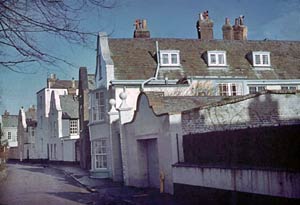 Dutch style houses at
Topsham, 1960s. Photo Jim Billsborough.
Dutch style houses at
Topsham, 1960s. Photo Jim Billsborough.
Some Topsham Trivia
• 1669 "In the month of June a Sturgeon was taken
by an inhabitant of this city in the river Exe, (opposite the Red Rock,
or Good-man's-well, on this side Topsham) which measured nine feet and
a half in length, and six feet in girth." (Jenkins)
• March 22nd 1924 - the largest salmon ever caught in the Exe weighed
61lbs and 7ozs (28 kilos). It was 3ft 9 inches (114 cms) long and 37
inches (94 cms) in girth. It was caught by James Richard Voysey of 1
Lower Shapter Street.
The first Topsham electricity station generated in DC.
• Vivian Leigh was married in 1932, at the age of 19, to solicitor
Herbert Leigh Holman who was from the Holman shipbuilding family of
Topsham. She often visited the town, before having a child, and embarking on
her affair with Lawrence Olivier and her part in Gone With the Wind.
• Dick Pym, the Exeter, Bolton
Wanderers and England goalkeeper was born and lived in the town.
• 48 Fore Street was once the Custom House.
Pilots to navigate shipping were introduced at Topsham in 1687.
• Salmon fishermen worked in teams of five, with one man holding the
licence. They each took a sixth share, with one going to the boat.
• Topsham once had 85 gas street lights to be lit and snuffed every
day.
• Thomas Hardy visited Topsham to pay his respect at the grave of
Tryphena Sparks. See Drakes - Fore Street.
• There have been at least 19 pubs or taverns in Topsham. See Exeter pub list
• The Parish Fire Engine was first housed in the Old Market Building in1837.
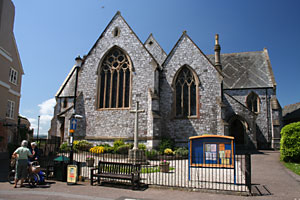 The Church at
Topsham
The Church at
Topsham
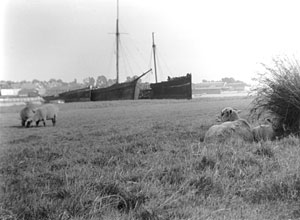 A
never published before view of Topsham in the 1930's showing hulks in
the mud. Photo by Maurice Swanborough
A
never published before view of Topsham in the 1930's showing hulks in
the mud. Photo by Maurice Swanborough
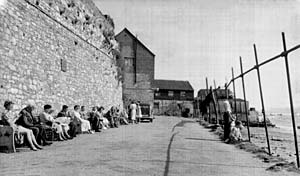 The
riverside in the early 1950's showing tourists admiring the fishing
nets hung out to dry. Photo courtesy of Paul Tucker
The
riverside in the early 1950's showing tourists admiring the fishing
nets hung out to dry. Photo courtesy of Paul Tucker
Some Topsham Street Names
Follett Road
Once called Upper Passage Lane, Follett Road is named after William
Webb Follet who was born in Follett Lodge during 1798. He was a
prominent lawyer who became Attorney General and the Solicitor General.
Monmouth Street
Originally called New Street it was renamed after the visit of the Duke
of Monmouth in 1685. It was much shorter until the late 1400 to early
1500's.
Lime Street
Along with Countess Wear and other local places, Topsham had a
lime-burning industry, which accounts for this name. Limestone was
imported from Berry Head and coal from South Wales and the North East.
Rope-Path or Rope Walk
Was named Victoria Road in
1913.
Exe Street was called Lower
Passage Lane.
Denver Road was called Pound
Lane
Nippon Road - army married
quarters named after the battle of Nippon Hill that took place in Burma
during 1944. The 1st Battalion, Devonshire Regiment were involved in
the action.
North Street was called
Trucklebed Alley before 1700.
Station Road was formerly
Taylors Lane. The station was built in 1860.
Greatwood Terrace was named
after Henry William Francis Greatwood. The south side was known as King
George Close.
Sir Alex Walk was named
after Sir Alexander Hamilton who lived in the Retreat.
Tresillian Cottages - the
first council houses in Topsham dating from 1926/8.
 The Lighter Inn and the King's Beam
The Lighter Inn and the King's Beam
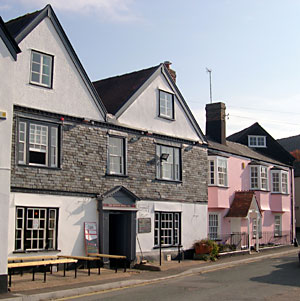 The
Passage House Inn
The
Passage House Inn
│ Top of Page │